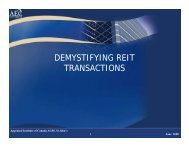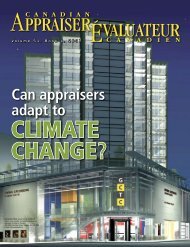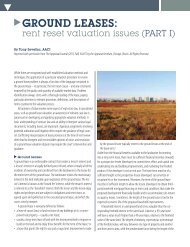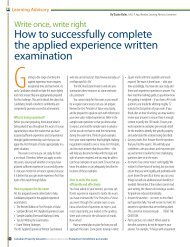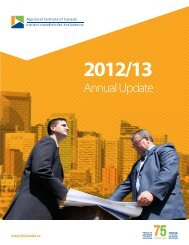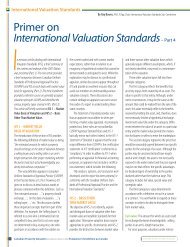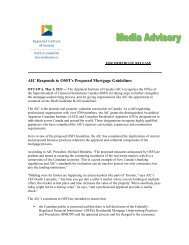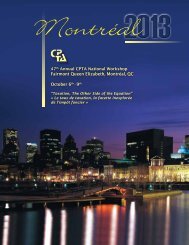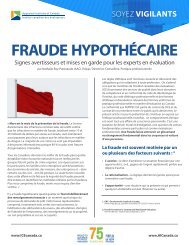Book 2 - Appraisal Institute of Canada
Book 2 - Appraisal Institute of Canada
Book 2 - Appraisal Institute of Canada
Create successful ePaper yourself
Turn your PDF publications into a flip-book with our unique Google optimized e-Paper software.
market value. Market value estimates must<br />
always be as <strong>of</strong> a fixed point in time, whether<br />
current, retrospective, or prospective. The<br />
standard definition <strong>of</strong> market value includes the<br />
concept <strong>of</strong> a ‘reasonable’ exposure time. Also, a<br />
‘reasonable’ marketing time is required in order<br />
to achieve market value. This one-lesson course<br />
explores the relationship between market value<br />
and time, focusing specifically on exposure and<br />
marketing time.<br />
Exposure time and marketing time are two<br />
important concepts which are <strong>of</strong>ten not given the<br />
attention they deserve in the appraisal process.<br />
<strong>Appraisal</strong> Standard Rule 6 <strong>of</strong> the Canadian Uniform<br />
Standards <strong>of</strong> Pr<strong>of</strong>essional <strong>Appraisal</strong> Practice<br />
(CUSPAP) requires that the appraiser include an<br />
analysis <strong>of</strong> ‘reasonable exposure time’ in each<br />
report. In other words, there is a compulsory<br />
compliance requirement that exposure time be<br />
dealt with in an appraisal assignment and in<br />
every appraisal report.<br />
The assumption <strong>of</strong> a ‘reasonable’ or<br />
‘adequate’ exposure period is a cornerstone <strong>of</strong><br />
most definitions <strong>of</strong> market value. If this period<br />
varies from normal, there is likely to be an impact<br />
– either on the market value estimate or the<br />
selling price <strong>of</strong> a property under review. It could<br />
be said that exposure time helps to shape the<br />
definition <strong>of</strong> market value. Therefore, it is imperative<br />
that the link be made between these two<br />
concepts in an appraisal report.<br />
Attention should also be drawn to the various<br />
market conditions where buyers and/or sellers<br />
may be atypically motivated. It is important for<br />
appraisers to be aware <strong>of</strong> these different conditions,<br />
so when researching sales, the measure<br />
<strong>of</strong> exposure can be a true reflection <strong>of</strong> ‘normal<br />
marketing conditions.’ Exposure time and motivation<br />
<strong>of</strong> one or the other parties to a sale are so<br />
interrelated, that when sales with such features<br />
are used in determining value or average days<br />
on market, the accuracy <strong>of</strong> one or the other must<br />
suffer – either the value estimate or the estimate<br />
<strong>of</strong> exposure time. Furthermore, by understanding<br />
the circumstances surrounding a sale, an<br />
appraiser is in a better position to accurately<br />
link exposure and marketing times to their final<br />
estimates <strong>of</strong> value. Therefore, an appraisal that<br />
considers these factors will more accurately<br />
reflect the conditions <strong>of</strong> the market and become<br />
more useful to clients.<br />
This course explores the relevance <strong>of</strong> an<br />
exposure time estimate and the need for clear and<br />
adequate disclosure <strong>of</strong> the estimate in a report,<br />
such that the reader clearly understands the<br />
concepts <strong>of</strong> exposure time and marketing time.<br />
Through an in-depth discussion and a series <strong>of</strong><br />
case studies, the course aims to clarify this <strong>of</strong>ten<br />
neglected aspect <strong>of</strong> appraisal assignments, so that<br />
appraisers across <strong>Canada</strong> may better serve their clients<br />
(as well as protect themselves from potential<br />
liability and meet pr<strong>of</strong>essional standards).<br />
CPD 118: Machinery and Equipment Valuation<br />
Machinery and equipment (M&E) are items <strong>of</strong><br />
personal property. This includes everything from<br />
the beds and televisions in a hotel room, to automobiles,<br />
trucks and other mobile equipment, to<br />
manufacturing equipment in plants and generators<br />
in power dams. M&E also includes the following:<br />
• Machine tools<br />
• Hand tools<br />
• Vehicles, boats<br />
• Chemical equipment and tanks<br />
• Furniture and supporting equipment<br />
• Communication equipment and computers<br />
• Farm equipment<br />
• Oilfield equipment<br />
• Restaurant equipment<br />
The valuation <strong>of</strong> M&E is a specialty branch <strong>of</strong> the<br />
appraisal field, combining technical machinery<br />
and equipment expertise with techniques from<br />
both business valuation and real estate appraisal.<br />
M&E appraisal assignments can differ from real<br />
property appraisals in many ways:<br />
• A determination <strong>of</strong> market value is not always<br />
the aim <strong>of</strong> the assignment.<br />
• M&E appraisals are <strong>of</strong>ten completed as part<br />
<strong>of</strong> complete business valuations that typically<br />
combine the need for expertise in real<br />
property values and analysis <strong>of</strong> the financial<br />
well-being <strong>of</strong> the business.<br />
• Analysis <strong>of</strong> M&E values requires identification<br />
and classification <strong>of</strong> the items to be valued<br />
(which is not always an easy task), and then<br />
determination about the condition and function<br />
<strong>of</strong> each item. The location <strong>of</strong> the item will,<br />
in most cases, make a difference in its value.<br />
• In an M&E assignment involving heavy or<br />
large machines, it is <strong>of</strong>ten difficult to know<br />
where to draw the line between where the<br />
machine ends and where the real property<br />
begins. For example, is the air conditioning<br />
that cools the employees, but is also needed<br />
to operate an engine production line within<br />
acceptable machined tolerances, part <strong>of</strong> the<br />
building or part <strong>of</strong> the M&E?<br />
• M&E values can be very detailed, requiring<br />
considerable inspection time and analysis,<br />
or completely summary in nature, where a<br />
complex assembly process is valued as only<br />
one line on the report.<br />
• M&E values can also involve the valuation <strong>of</strong><br />
chattels, including horses and livestock.<br />
In spite <strong>of</strong> these complications, the CUSPAP still<br />
apply to machinery and equipment appraisal<br />
assignments. CUSPAP discusses personal property<br />
as follows:<br />
Personal property: including tangible or<br />
intangible items that are not real property, but<br />
that are included in the appraisal. May be omitted<br />
when not relevant to the assignment, otherwise<br />
competency in personal property appraisal<br />
is required when it is necessary to allocate overall<br />
value. (CUSPAP section 7.23, 2008)<br />
This two-lesson course introduces concepts<br />
and techniques for the valuation <strong>of</strong> machinery<br />
and equipment. The intent <strong>of</strong> the course is to<br />
build awareness <strong>of</strong> this topic, either as a potential<br />
area <strong>of</strong> specialization for appraisers or at minimum<br />
so appraisers are more familiar with the<br />
‘what, why, and how’ <strong>of</strong> machinery and equipment<br />
valuation, should they come across M&E<br />
issues as a part <strong>of</strong> real estate assignments.<br />
Much <strong>of</strong> the first lesson is devoted to outlining<br />
the various types <strong>of</strong> machinery and equipment<br />
valuation assignments and the value definitions<br />
that apply. After, the resources and methods<br />
that are available to complete the appraisal are<br />
discussed, including simple examples using the<br />
income, cost, and direct comparison approaches.<br />
The second lesson provides case studies that<br />
illustrate the practical application <strong>of</strong> these techniques<br />
in a variety <strong>of</strong> real-world scenarios.<br />
38<br />
Canadian Property Valuation Volume 52 | book 2 | 2008 Évaluation Immobilière au <strong>Canada</strong>



